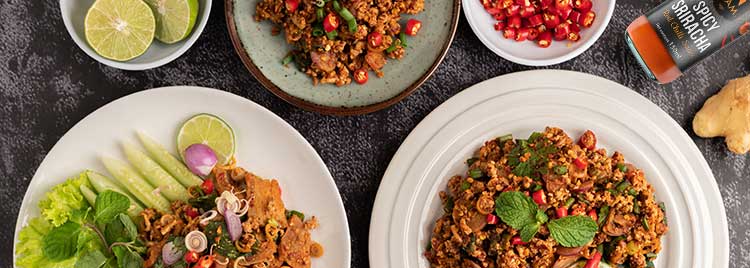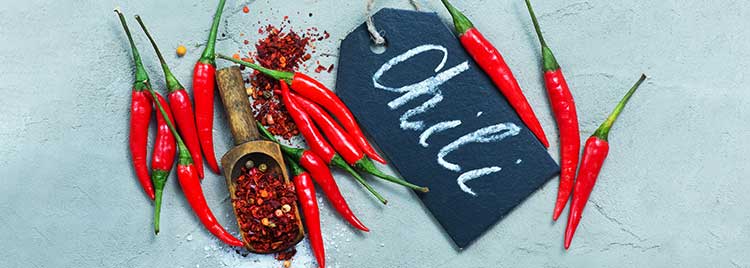My shopping cart
Your cart is currently empty.
Continue Shopping
Thai food is famous for its spiciness and not everyone can handle that. However, the good news is you can improve your tolerance for spicy food. Here are some of our tips how to handle, eat, and how to soothe the burn afterwards, so you can enjoy that burning sensation just like the locals.
Start small and increase slowly
If you grew up without much experience of a spicy diet, allow your body to grow accustomed to spiciness slowly. Eating spicy food is a lot like doing sports or any other activity where practice can improve endurance. The main chemical in chili peppers responsible for the heat is called capsaicin. As you eat spicy food, the nerve cells in your tongue send a signal to your brain. That signal is what is processed as a burning sensation in your mouth. The more you eat spicy food, you will develop a resistance to some of capsaicin’s effects. Thai food has several levels of spiciness, and most of the time Thai chefs are happy to customize the spiciness by your request. You can start from choosing mild spicy food in nature like Massaman Curry or Yellow Curry (Gaeng Garee) or order a Som Tam dish with 1 or 2 chilis. Once your taste buds get accustomed to these small measures of spice, you can reach the next level by choosing spicier curries like Green Curry or adding more chopped chillis to your food.

Keep it on the side
You can keep spicy condiments like Sriracha sauce, Chilli Tamarind sauce or Phrik Nam Pla (Fish sauce with chillies) on the side, so you can add to your liking and can increase the spicy taste bit by bit. This idea is also useful if you are trying to increase your tolerance while other people in your family may not be as interested in doing so.
Don't Force it
The goal is to enjoy spicy food, but not everyone’s stomach can handle it. It is okay if you feel like you can’t increase your tolerance for spicy food or have repeatedly experience pain after having spicy diet, then you should stop. Not all delicious Thai food are spicy, it is just more exciting experience if you can handle it. However, so much of Thai cuisine is mild or not spicy at all that you can explore.
Eat Slowly
You don’t need to rush. Take your time to enjoy the flavor and adjust to the spicy dish. Each time you take the food to your mouth, the receptors send signals to your brain and the effect is renewed. So you should take it slow and wait for the burning sensation to wear out before you take the next bite. It is also recommended to have at least one other food that is not spicy at all by the side. Taking a bite of other foods may help your mouth to cool down faster and help you find a balance to eat your spicy food.

Breathe
While eating hot and spicy food, exhaling through the mouth helps cool down your mouth. Try to take a slow, deep breathe in and out, this helps send cool air to those capsaicin receptors. This is better than drinking cool plain water which doesn’t help much. Some people might make noise while exhaling which might be a little strange if you eat with other Thai people. However, they will understand that you are trying to cope with the pain, so it is still acceptable.
Reach for some dairy, or acidic drinks
If the hot sensation is becoming too much, try to drink a milk-based product or something acidic. Sorry but cold water cannot help you in this case since capsaicin is oil-based and not water soluble, drinking water will basically just spread this molecule around your mouth. Milk and dairy products, however, can help. Many milk-based products contain a protein called casein, which help break down capsaicin enough that it can't bind to those pain receptors. But the dairy product you choose must contain casein to make this trick work. Some products include cow milk (not almond, or soy milk), yogurt, cottage cheese or sour cream. So order some smoothies, Thai milk tea, or milk-based ice cream after you have spicy Thai food can be a good idea. Acidic food or drink can also cool your mouth down. Capsaicin is an alkaline molecule, so balancing it with acid can help neutralize the molecule's activity. Acidic drinks such as lemonade, limeade, orange juice, soft drinks or a tomato-based food is a good option.
Eat more rice or sugar
Sugars and carbohydrates also replace the capsaicin on the receptors and tame the heat down. Typically, Thai food is served with steamed rice, so it can help you deal with spicy food. But be careful, do not put too much spicy food or curry on top of the rice, or you will lose your safety blanket. You can have some starch and sugar based desserts to aid the heat like Banana Choco Spring Rolls or Thai Coconut Flan. Or if you feel like having enough carbohydrate during the meal, you can opt for fresh fruits or Salacca Fruit in Syrup which will help clear your palate are very refreshing.

Cold soothes burns, whether caused by actual heat or capsaicin. After a spicy meal, it is a good idea to have something cold, fatty and sweet to tame down the heat in your mouth and soften the pain in stomach that may come later. Try eating cold fruit (which contain sugars) or ice cream (which contains sugars and casein). Yoghurt or a milkshake which is cold, fat, sugary and has a coating effect, is also a good choice. You can use this technique before you eat spicy food to help numb your nerve receptors and coat your stomach.